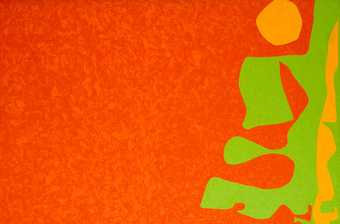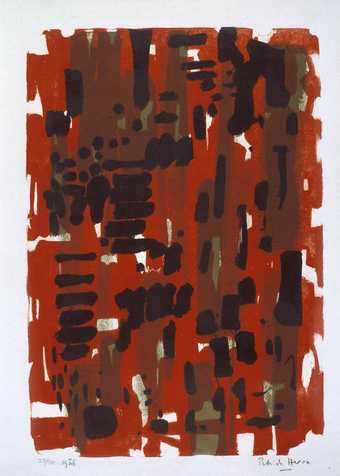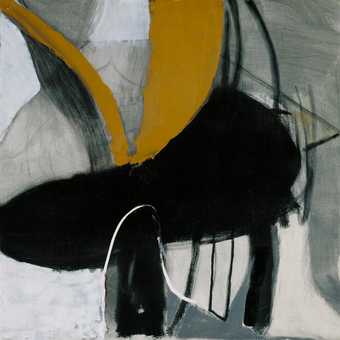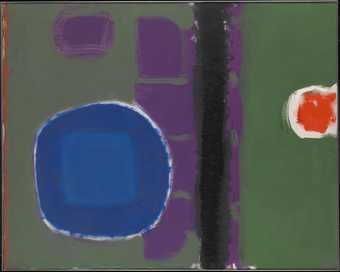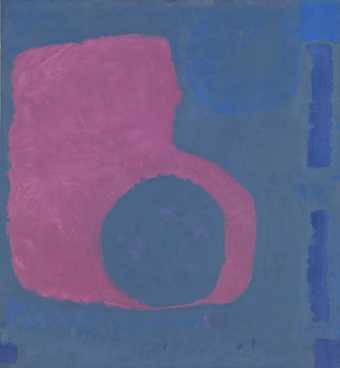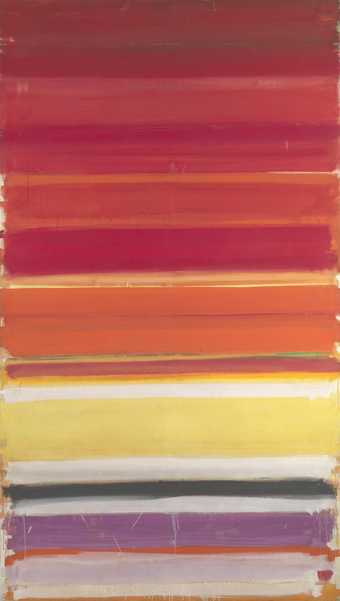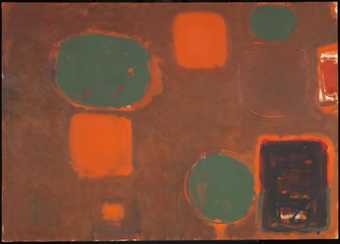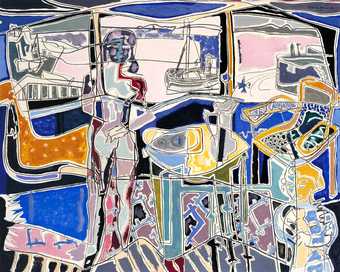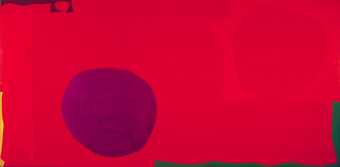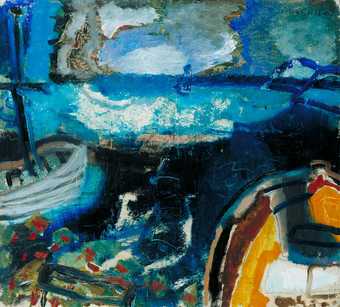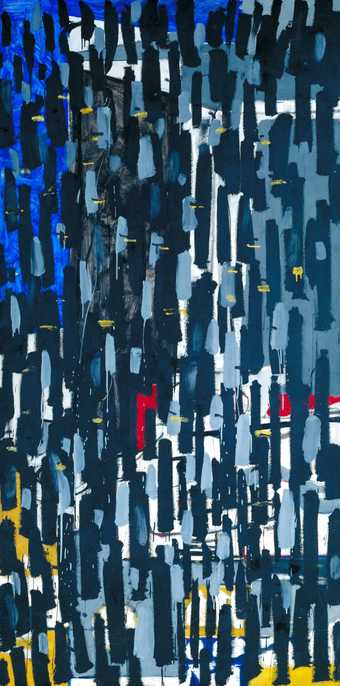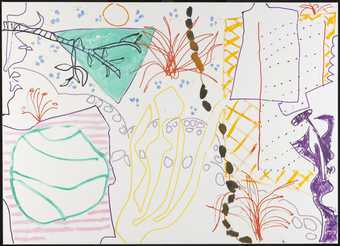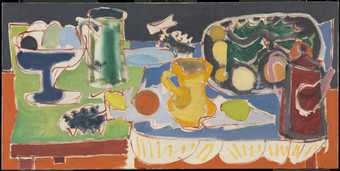
Not on display
- Artist
- Patrick Heron 1920–1999
- Medium
- Oil paint on canvas
- Dimensions
- Support: 1524 × 1276 mm
- Collection
- Tate
- Acquisition
- Purchased 1980
- Reference
- T03107
Display caption
Heron first made his name as a critic but by 1956 was well established as a painter. Inspired by his Cornish garden, Heron painted this picture during a period when he saw himself moving from representational art to abstraction. He recalled: ‘I referred to the series as garden paintings, since they certainly related in my mind to the extraordinary effervescence of flowering azaleas and camellias which was erupting all over the garden’. Though he regarded the formal qualities of a painting as paramount, he also believed in the importance of subject matter.
Gallery label, September 2016
Does this text contain inaccurate information or language that you feel we should improve or change? We would like to hear from you.
Catalogue entry
T03107 AZALEA GARDEN: MAY 1956 1956
Inscribed on stretcher ‘Azalea Garden: 1956 Patrick Heron’ and on ‘200 gns’
Oil on canvas, 60 × 50 3/4 (152.4 × 127.3)
Purchased from the Waddington Galleries (Grant-in-Aid) 1980
Exh: Patrick Heron, Mary Fedden, Robert MacGowan, Redfern Gallery, June 1956 (8); Retrospective: Patrick Heron, Richard Demarco Gallery, Edinburgh, June–July 1967 (41)
In a letter (27 April 1983) to the compiler Patrick Heron wrote:
“Azalea Garden: May 1956”
'This was one of the paintings made in the first months at Eagles Nest, and exhibited together in my sixth exhibition at the Redfern Gallery, in June 1956. Although called Tachist by many at the time, I referred to the series as “garden paintings”, since they certainly related in my mind to the extraordinary effervescence of flowering azaleas and camellias which was errupting all over the garden, amongst the granite boulders, at Eagles Nest when we moved down to begin our lives here. Having bought the house the previous August we nevertheless did not occupy it until April 1956. The well-known crisis which confronted many British painters of my generation -I mean the moving over from overt figuration, however abstract, to overt non-figuration, overtook me at about this time. Actually, my first non-figurative works (apart from those of 1952 which had no follow through) were arrived at in 1955, in London, and were decidedly Tachist and unrelated to any external scene (Winter Harbour 1955/56 is the exception)-related only, I think, to scribbled passages of paint in my immediately preceeding “figurative” paintings. In retrospect, I used to rather point to a certain continuity of texture and brush stabs between these garden paintings and a number of the last figurative paintings in which, as it were, Tachist blobs were used to infill between the charcoal lines of drawing; these can be seen in the big largely grey and white painting called Girl in Harbour Room: 1955 or Round White Table: 1953–54, which was a London memory of the St Ives window. Although one is always intrigued, after the event, to notice similar characteristics occurring in the paintings of one's different periods-as though one needed to feel that there was an underlying unity and continuing consistency, formally speaking (“To ourselves we are never a unity”, said Yeats) the fact is that all transitions strike one at the time as being wholly chaotic and terrifying; one seems, at the time of change, to be jeopardising one's entire art, and the difference is seen as very extreme indeed. This was certainly the case when I ventured to make these “garden paintings”. However, again with the passage of time, it is quite extraordinary how closely these apparently different “periods” seem to draw together again. Perhaps the main stimulus which caused my Tachist paintings to be made was the fantastic nature of the white light at Zennor, although now-a-days one cannot mention the subject of “Cornish light” without appearing to succumb to cliche, so often has this now been noted. But again I would like to make the point that these “garden paintings” had their nearest formal equivalents quite outside St Ives painting as it then existed. My interest in the visible registration of a paint-laden brush took over at this time and excluded, for over ten years, all trace, for instance, of the linear. At each period it seems that what one is doing is bringing together different ingredients, in a different selection, from the total mix of one's personal interests. There was a contrast that seemed quite violent between the broad brush marks of the “garden paintings” and the often invisibly amalgamated brush-weaving of the colour surfaces in both my earlier and my much more recent works. Yet my total interests include both these modes.’
Published in:
The Tate Gallery 1980-82: Illustrated Catalogue of Acquisitions, London 1984
Features
Explore
- abstraction(8,615)
-
- from recognisable sources(3,634)
-
- landscape(1,191)
- non-representational(6,161)
-
- colour(2,481)
- garden structures(1,939)
-
- garden(1,191)
- formal qualities(12,454)
- UK cities, towns and villages(12,725)
- Cornwall(1,034)
- England(19,202)
- England, South West(3,507)
- England, Southern(8,982)
You might like
-
Patrick Heron Scarlet, Emerald, and Orange : July-September 1976
1976 -
Patrick Heron Red Garden : 1956
1956 -
Roger Hilton January 1957
1957 -
Patrick Heron Green and Purple Painting with Blue Disc : May 1960
1960 -
Patrick Heron Purple Shape in Blue : 1964
1964 -
Patrick Heron Scarlet, Lemon and Ultramarine : March 1957
1957 -
Patrick Heron Horizontal Stripe Painting : November 1957 - January 1958
1957–8 -
Patrick Heron Brown Ground with Soft Red and Green : August 1958 - July 1959
1958–9 -
Patrick Heron Harbour Window with Two Figures : St Ives : July 1950
1950 -
Patrick Heron Cadmium with Violet, Scarlet, Emerald, Lemon and Venetian : 1969
1969 -
Patrick Heron Boats at Night : 1947
1947 -
Patrick Heron Vertical : January 1956
1956 -
Patrick Heron 10-11 July : 1992
1992 -
Patrick Heron The Long Table with Fruit : 1949
1949 -
Patrick Heron Yellow Painting : October 1958 May/June 1959
1958–9

